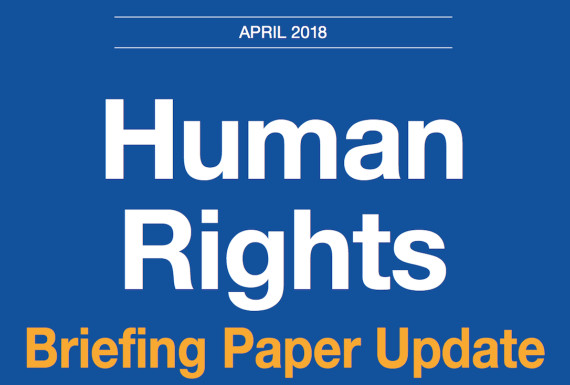Communicating about progress and performance
Many companies are experiencing increasing pressure from both stakeholders and regulatory requirements to report how they manage human rights issues.
Business partners. Investors. Civil society organisations. Corporate regulators. Stock exchanges. Consumers. People want to know what a company’s salient human rights risks are, how it identifies such risks and what action it takes to address any problems.
For some, formal reporting and disclosure can feel like walking a tightrope. On the one hand, stakeholders understandably want access to as much information as possible. But on the other, there are limitations as to what information it’s practical – and appropriate – to share. For companies that prepare integrated sustainability reports, word counts can be tight. And human rights issues and progress can be hard to measure. Ultimately, it’s important to focus on what's meaningful to help stakeholders assess the company’s performance and to drive positive outcomes on the ground.
Done well, reporting and disclosure can be good for the business. Increased openness – about what works and what doesn’t – builds trust with stakeholders. And by strengthening stakeholders’ understanding of key challenges, reporting can support collaboration and coordination.
What does reporting and disclosure look like in practice?
Ways to get information for reporting and disclosure:
- Use internal reporting processes to get information from key functions and parts of the business.
- Collaborate with colleagues to identify relevant information, case studies and stories.
- Draw on the findings of impact assessment, audit and grievance processes.
Ways to report on or disclose information about human rights progress and performance:
- Integrate information about the company's efforts to manage human rights risks into annual reports.
- Develop a standalone human rights report or briefing.
- Share material online and through relevant benchmarking processes.
What do the UN Guiding Principles say about reporting?
The UN Guiding Principles on Business and Human Rights, or UNGPs, expect companies to communicate about how they address their human rights impacts, including through formal reporting and disclosure processes.
Key guidance on reporting and disclosure include:
- A company's efforts to communicate should be of a form and frequency that reflect its human rights impacts – and that are accessible to its intended audiences.
- Reporting and disclosure should provide information that is sufficient to evaluate the adequacy of a company’s response to particular human rights risks and impacts.
- Human rights reports and disclosures should not pose a risk to affected people, personnel or to the legitimate requirements of commercial confidentiality.
- Formal reporting is expected where risks of severe human rights impacts exist – whether this is due to the nature of the business operations or operating context.
See Guiding Principle 21 for more.
Examples of human right reporting from our members
Insights from business practice
-
Good reporting and disclosure can strengthen relationships and dialogue with key stakeholders
Human rights reporting can help you engage more effectively with stakeholders – including governments, investors, civil society organisations, customers and other business partners, as well as consumers and local communities. It presents an opportunity to help people understand the company’s human rights risks and challenges, and the complexity of its business relationships and operating environment. When everyone has a stronger understanding of these things, you can have a more mature conversation about how these challenges should be managed.
Opening up about the company’s challenges – and its approach to managing these – can also give a company’s business partners and its own employees confidence to raise dilemmas they are facing, improving the company’s visibility of these risks and ability to help find solutions.
-
Report in a way that works for your company
There are many mechanisms a company can use to report on or disclose information about its human rights policies, processes, progress and performance. These include:
- integrating human rights information into an integrated annual or corporate responsibility report.
- preparing a standalone human rights report.
- publishing a modern slavery statement.
- disclosing information on the company's website or through an app.
- making disclosures through an industry or multistakeholder initiative.
There is no one right way to approach this.
What works best for your company will likely reflect legal requirements in countries where it operates and the company’s preferred approach to non-financial reporting. It will also depend on its salient issues, opportunities to make disclosures through industry initiatives and – importantly – who its key stakeholders are and what information they want or need.
Most companies combine multiple approaches – for example, they may share some information on the company’s website and supplement that with a more formal human rights or sustainability report. They may also make specific disclosures prepared to comply with regulatory requirements or industry expectations – for example, by making a modern slavery statement or reporting through the Voluntary Principles on Security and Human Rights.
-
The UN Guiding Principles Reporting Framework is a helpful reporting and management tool
The UN Guiding Principles Reporting Framework can be used to strengthen formal reporting by helping companies present a comprehensive picture of how they identify and manage human rights challenges. It helps companies focus on the issues that are most relevant to stakeholders. Practitioners observe that this Framework can also be used to spark internal conversations and to strengthen management policies and processes.
There are a broad range of other tools and frameworks that companies use to guide how they report on human rights and other responsible business issues. Some companies choose to develop one report that meets the requirements of a number of frameworks or tools, and annex an analysis showing where information required by each framework can be found in the report. It may not be necessary to report against each framework or tool – some practitioners note that their company’s stakeholders tend to be more interested in some types of reporting than others.
-
Engage early and often with key internal stakeholders as you develop content for a report
To report on human rights issues, you will need to engage with colleagues from different functions and parts of the business. For example, to gather relevant information and to secure the necessary approvals. Having strong leadership buy-in from the beginning can help encourage support from colleagues across the business.
Engaging early and often with key colleagues – particularly those who may be cautious about communicating publicly on human rights-related issues – is key to building comfort and confidence in this work.
-
Be creative and collaborative to gather relevant information for reporting and disclosure
To report on human rights progress and performance, you will need information from a variety of functions and parts of the business to report on the company’s human rights-related policies, processes, progress and performance. Ideally, such information should be contained in a company-wide reporting tool.
Think creatively and collaboratively about how to get this. Processes to collect information for reporting and disclosure are often a continuation of other information-gathering processes. For example, it may be helpful to draw on systems developed to support human rights due diligence and grievance processes. In-person workshops with colleagues from specific functions or regions can also help develop and test content. It is important to think critically about the reliability of information sources and their interpretation – for example, if a grievance mechanism isn’t trusted, the data it generates may not be complete.
Assessing the impact of a company’s efforts to implement respect for human rights can be much more difficult than gathering information and data on compliance with company policies, participation in training programmes and identified grievances or incidents.
-
Honesty and openness tend to be well-received by stakeholders
Companies are generally comfortable communicating about successes and achievements. Reporting on challenges, mistakes and areas where improvement is needed can be more difficult. However, honest and open reporting about the often messy realities of managing human rights risks tends to be received well by companies’ stakeholders. Being real about your challenges and dilemmas, as well as what's working well, can build trust and help stakeholders find ways to work with the company to drive positive outcomes.
It is important to work closely with lawyers to navigate concerns about any legal risks that may arise from disclosing information about human rights issues. Bringing them in early can help build comfort and buy-in. Some companies ‘test the waters’ by communicating about human rights challenges through one mechanism (such as the UN Global Compact Communication on Progress process), then become more open with their reporting and disclosure when they feel ready.
Looking forward: Strengthening reporting to improve engagement
It’s no surprise that there’s a strong focus on how companies report on human rights challenges. After all, what gets measured, gets managed.
We’ve seen a significant increase in the quantity and quality of companies' human rights reporting and disclosure in recent years. We also see a number of opportunities to further strengthen reporting and disclosure – and its impact.
Places to start include:
Measuring performance and outcomes: Finding rigorous ways to assess – and then report on – whether a company’s actions achieve meaningful human rights outcomes remains challenging. It’s easy to find out how many employees have completed human rights training, and what types of complaints are being raised through grievance mechanisms. But determining whether the implementation of a new human rights due diligence process has prevented impacts from happening is much harder. Business practitioners see a real need as well as opportunities to advance practice in this area – for example through the recently launched Valuing Respect platform.
Getting clear about how reporting drives meaningful change: There are strong drivers for companies to report on how they manage human rights-related challenges. These include high profile benchmarking initiatives and a variety of reporting frameworks and standards with strong stakeholder support. These drivers require practitioners to make smart choices about how to report efficiently to improve stakeholders’ access to information without diverting resources and attention from actually managing human rights challenges.






 Download, PDF
Download, PDF

